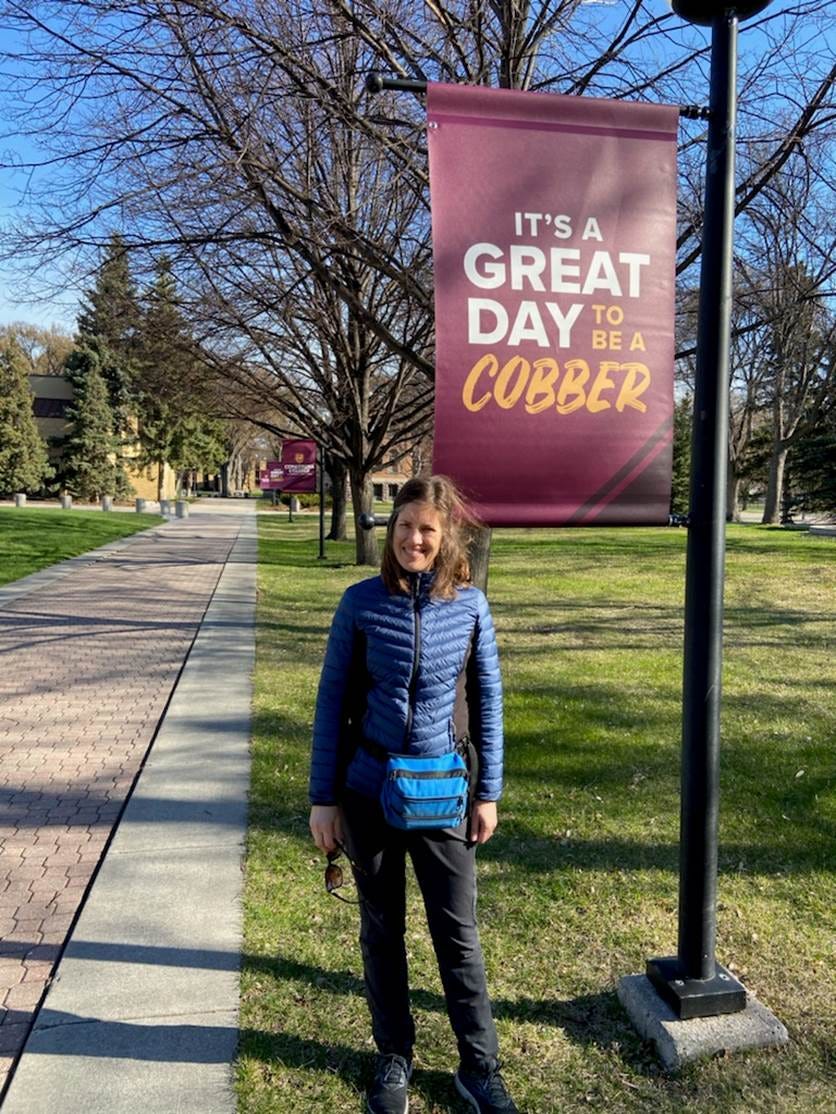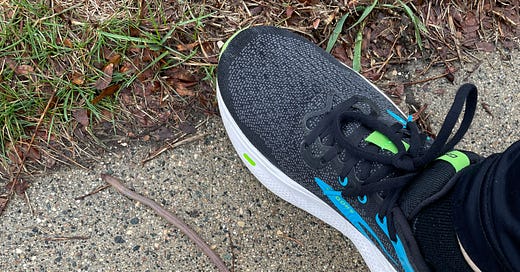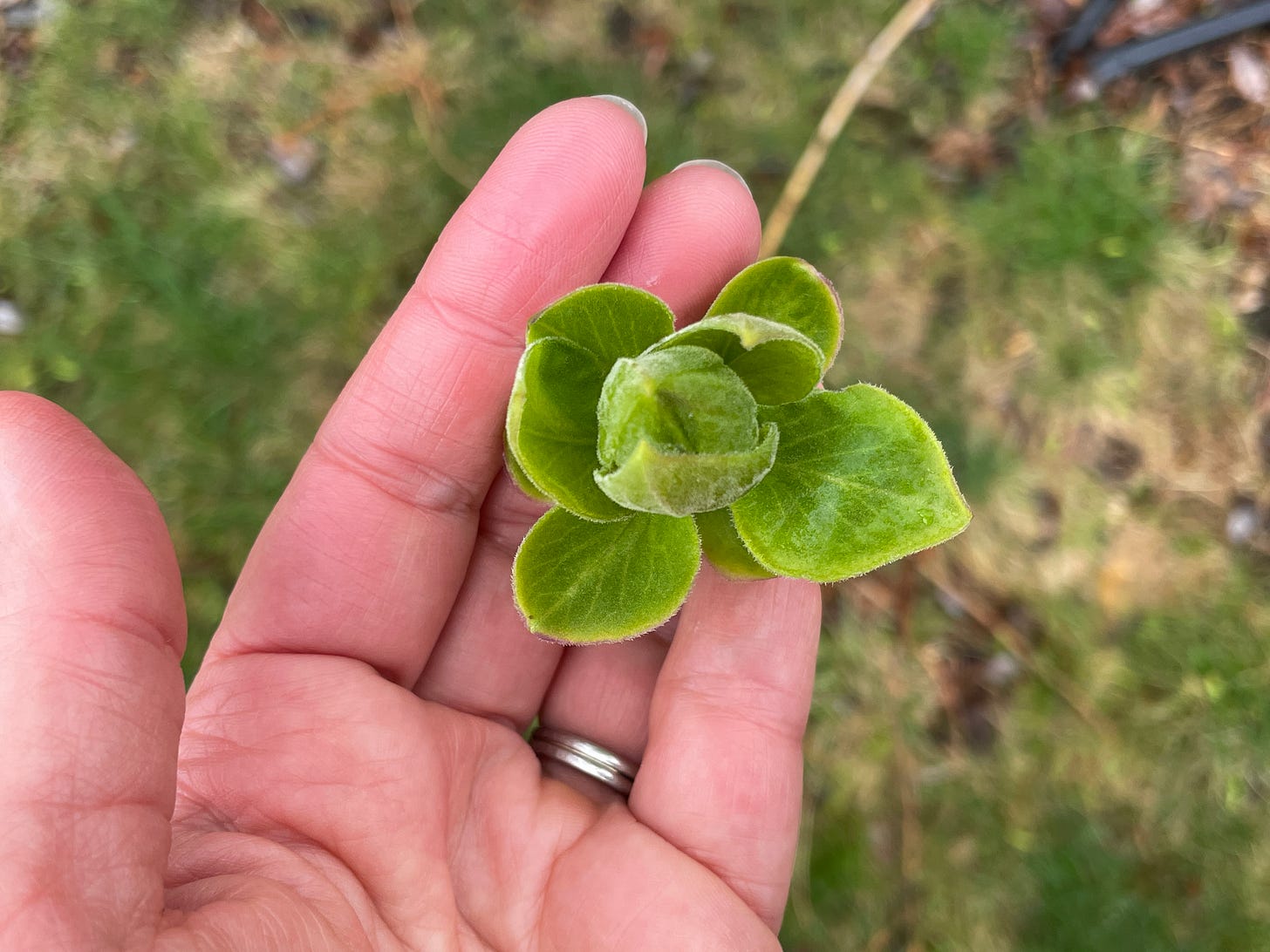“It’s a good day to be a robin.”
That’s what I said to myself on a rainy Monday morning as I started out on a 3-mile run and saw this earthworm.
Yes, that is my foot next to it, and let’s just say I don’t have small feet. (In fact, some years back I started wearing men’s Brooks running shoes and LOVE the ample toe box. In case you’re wondering, these are the Ghost Max model, and they are comfy.)
I’m preparing for our local 10K, my annual crack at this distance, and following a new training regimen by Hal Higdon (we were introduced by Google). His novice plan is helping me make more progress than I expected.
My primary race goal is to run the whole 10K pain-free, which is more like two goals, but you get the idea. I’m not really competitive, but I do also have a loosely held secondary goal, which is to run this year’s 10K as fast as last year’s. We shall see.
For me, feats of speed and strength are opportunities to a) prove I might still be able to outrun a bear, at least distance-wise, and b) run in a crowd, an activity I find oddly exhilarating. Maybe it’s because our Minnesota-North Dakota winters are so long and harsh, and require much layering and bundling. It’s a bit of a rush to be surrounded by thousands of people outside at the same time, all having emerged from their cocoons of parkas, mitts and sturdy boots, now flitting about in brightly hued running gear.
If I’m honest, there is also a c) to this list, and that is my desire to continue doing an activity—running—that my mom would never in a million years have signed up for and that I think might have helped her live longer and healthier if she had. Because I do want to live longer than she did … or at least healthier than she did for as long as I’ve got. Dementia was a bear. And maybe that is what I’m really trying to outrun.
Back to the robins and the worms.
On that Monday morning run I actually saw very few robins—didn’t they know they were missing a huge opportunity?—but I spent all three miles dodging worms, which were slowly meandering across sidewalks and streets.
When I was little, my mom encouraged me to move worms off the sidewalk and put them in the grass, so they wouldn’t dry out and die. Or, I suppose, get stepped on. She picked them up gently in her long, thin fingers and relocated them as if she was sorting ribbons.
I watched but opted out. I didn’t particularly like their fleshy color or the way they flinched when I tapped them with a twig serving as my test finger. I just wasn’t that kind of girl. Neither was my aunt, my mom’s little sister. When I got older, my mom would tell me of how she used to chase my aunt with worms. Thankfully, I escaped that fate. My mom just called me “a pansy” and, now and then, “a pantywaist,” which is a strange word to use when you’re trying to draw someone out of their fear zone.
I finally looked up “pantywaist” this week, and according to Merriam-Webster it’s “a child's garment consisting of short pants buttoned to a waist” with a second meaning of “sissy,” which I had figured. But we all knew that pansies were lovely, sturdy little flowers that people enjoyed looking at, especially the purple ones. Even as a kid I figured being a pansy wasn’t all bad. It was better than picking up worms.
In recent years, particularly since my mom passed, I actually have started picking up and relocating the odd worm myself. Just now and then. Maybe it’s because she’s no longer here to do it … or to needle me about not doing it. That’s how our relationship went sometimes.
So that habit finally rubbed off, sort of, but more than that, what Mom transferred to me was her heart and compassion for animals and plants. Toward the end of her life, she started saying that she preferred the company of animals over people, which I think was really the dementia talking. She had an extraordinarily active social life—with people—up until then.
But the idea of loving the animals started to really take hold of her during her final winter. She shared her worries with me about the poor rabbits, squirrels and deer living outside in my parents’ neighborhood in the cold, snowy winter. For a while she got stuck on the deer, so I offered to invite a few inside—talk about playing chicken. But, I added ominously, I wasn’t sure if we would be able to train them to use Miss Kitty’s litterbox.
The good thing is, what my mom loved even more than the animals, was keeping a tidy house. Even though things had gone a bit downhill in the tidiness department during the dementia years, the idea of deer leaving piles of poo on the carpet seemed to help her let go of some of her worries about their welfare.
On Monday, as I ran, I wondered about other walkers and runners, and whether they were doing the hard work of avoiding the worms. Or whether any of them were moving them out of the way. The poor things moved so slowly. It must be a tough day to be a worm, I thought, remembering my runs with Leo the dog and how my sweet beast seemed so skilled at avoiding errant poops left on the sidewalk by his canine compadres but was merciless when it came to stomping and tromping on any lower life form in his path. Was it intentional? Or was he that clueless?
I had spent much of the five days prior to that run in a yoga and neuroscience conference, which was fascinating and gave me all sorts of research-backed reasons to increase and expand my yoga practice, and encourage others to do the same. Some of the speakers also delved into the idea of common consciousness and how a yoga practice including meditation and movement can help heal the world.
Maybe it was out of those ideas that my thoughts on worms started shifting. I began to consider that while some of them might make it off the path and back into the spring grass to aerate the soil and create more worms, others could fulfill their purpose in life by feeding the robins who lay those sky-blue eggs and look so clever on their head-tilting hunting expeditions.
In that case, perhaps Monday was actually a good day to be a worm. And where were those robins anyway?
Recently I called an old friend. By that I mean a friend I’ve known my whole life, because she’s one of my mom’s childhood friends. Plus she’s 83 now, which I hope you don’t mind me saying is pretty old, although now that I’m in my mid-50s it sounds younger than it used to. I learned that she had entered hospice care last week, which wasn’t terribly shocking but a sad surprise. The previous week I had gone to the funeral of a 97-year-old teacher of mine, and the week before that to the memorial service of our 63-year-old neighbor, who had fallen in the river. The losses just keep piling up.
My 83-year-old friend said that learning she needed to enter hospice care was “kind of a blow,” but she is now feeling confident that with that extra support she now can enjoy every day. She said that a few times, actually, that she was enjoying every day. She goes to church, to her appointments and walking in her retirement community with friends, using a walker now. A lifelong fitness buff, she’s still attending senior fitness classes and working out on machines in the fitness room. “I really have a good workout,” she assured me.
Hospice care begins when a person is expected to live no longer than six months, according to the American Cancer Society, but I’ve heard stories of people who are on hospice three times that and even leave hospice care. Today I am thinking of my friend, who in her possibly limited time, is spending it staying fit. Because you never know, right? And I am thinking of the ways I spend my time, sometimes wisely, sometimes not, because no one has told me yet that my time is limited—but I know this limitlessness is an illusion.
My old friend lives far from me, so I asked her how I could best support her in this new stage of life. She asked for my prayers. But she also suggested we could talk on the phone more often—like maybe every six weeks. I suggested we should talk more often than that, so I have her on my calendar for late May. But I actually plan to move that up to the middle of the month.
I realized the day after receiving this hard news that our conversation, my friend’s attitude, had encouraged me. It, and the worms and the lack of robins, made me wonder, How do we know what makes a particular day a good day for any of us?
I heard
’s podcast recently featuring Annie B. Jones, the author of a new book called Ordinary Time: Lessons Learned While Staying Put. Jones spoke of the freedom that comes from making a conscious decision to live a quiet, even “ordinary” life. We have dreams, and then we have our actual lives, and it’s easy to get stuck on all we Need to Get Done and how much we have Not Yet Accomplished.Sometimes I remember to embrace the ordinariness of life, the miracle that today I opened my eyes and found that my lungs were still filling and emptying, and when I went out to the kitchen, Jon had already poured tea into my mug. How is that not the beginning of a good day?
Yesterday, following Hal’s 10K plan, I got out for another ordinary-day run around the neighborhood and turned in what was probably my fastest mile since 2019. (There were no worms on the sidewalk.) I am not an athlete, and obviously I am getting older, and when I set out I had no intention of breaking any speed records, so this felt like a crazy miracle.
It makes me think that any day we are still here is an opportunity to do one thing that we love, whether it’s going for a run, picking up worms, or visiting with a friend or co-worker. Every day brings an opportunity to encourage each other in life, to sense our callings and to do at least one small thing that answers them.
Today, on this Thursday morning, as I reflect on those we’ve lost and those who are still here, I’m not sure what is ahead. But I’m hopeful that today will be a good day. For you and for me.
With all best wishes,
Sarah

Reminder: Everyone who becomes a paid subscriber by May 15, 2025, will be entered in a drawing to win one of two (or more) copies of my Japan memoir, The Same Moon. (Why this? Why now? It’s our 5-year anniversary!)
Share your thoughts
What makes a day good—or great—for you?








I, too, am feeling like the losses are piling up. One of the hardest challenges of this season to lose so many people who are pillars of our childhood.